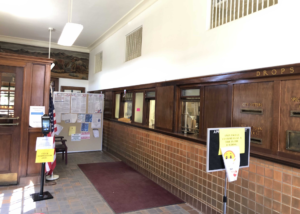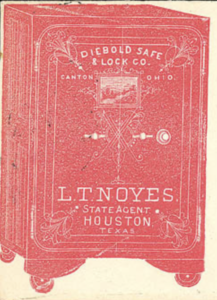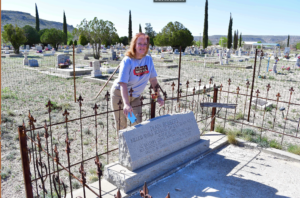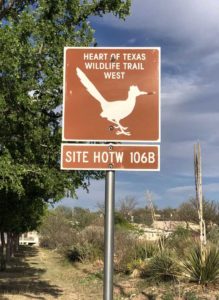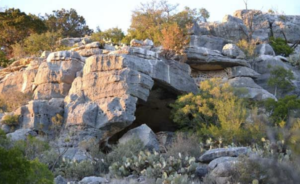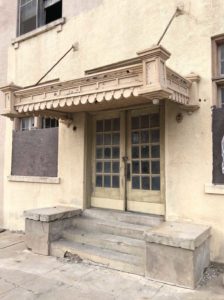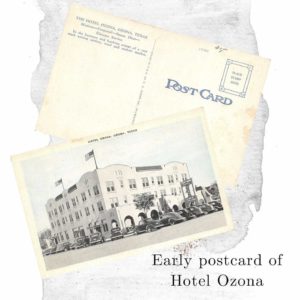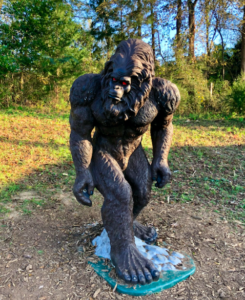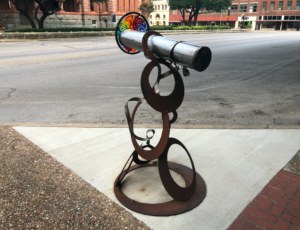
Have you ever heard of a corpse being fined for carrying a concealed weapon? Or how a stunt pulled in a middle-of-nowhere town in Texas threw the New York Stock Exchange into a panic?
If not, you might not be familiar with Judge Roy Bean’s unique version of “justice” in the Old West. It’s one of the stories my grandfather told me about the notorious lawman – and I’m using the term “lawman” pretty loosely here – that has stayed with me.
 When I was a kid, I found an old postcard of The Jersey Lilly on my grandfather’s desk. That’s when he told me some of the stories about Bean. I decided then and there I would see it for myself someday. It took me a l-o-n-g time, but I never forgot about it and finally got there.
When I was a kid, I found an old postcard of The Jersey Lilly on my grandfather’s desk. That’s when he told me some of the stories about Bean. I decided then and there I would see it for myself someday. It took me a l-o-n-g time, but I never forgot about it and finally got there.
 Judge Roy Bean. The name that should bring to mind the colorful history of the Wild West, might actually bring to mind the image of Paul Newman in his role playing the famous figure. O.K., well that’s not bad, but the original Bean is a pretty interesting fellow too. Known as the “Law West of the Pecos,” Bean created his own brand of justice with decisions and decrees that came out of the courtroom he called the “Jersey Lilly” inspired countless books and stories.
Judge Roy Bean. The name that should bring to mind the colorful history of the Wild West, might actually bring to mind the image of Paul Newman in his role playing the famous figure. O.K., well that’s not bad, but the original Bean is a pretty interesting fellow too. Known as the “Law West of the Pecos,” Bean created his own brand of justice with decisions and decrees that came out of the courtroom he called the “Jersey Lilly” inspired countless books and stories.
But let’s back up just a little.
The silver spike that joined the transcontinental tracks of the Southern Pacific’s Sunset Route in 1883 was driven into the ground at nearby Dead Man’s Gulch, connecting train service from New Orleans to San Francisco. The new towns that sprung up along the tracks quickly filled up with rowdies like gamblers, thieves, painted ladies and more. And chaos reigned.
That was a big problem, since the nearest Texas Rangers were 100 miles away. They suggested the townspeople in Langtry appoint a local justice of the peace.
In nearby Vinegarroon, a town named after a whip scorpion by the way, a man named Roy Bean ran a store out of a tent. The locals must have thought he had enough common sense to be in charge, because they appointed him the first Justice of the Peace of Pecos County (now Val Verde County). His brother Joshua, after all, was the first mayor of San Diego.
Now, Bean wasn’t your ordinary representative of the law. His “law library” only included one book: the 1879 edition of the Revised Statutes of Texas. Not that he every consulted it. In fact, pretty much the only law he represented was his own. Need an example?
When a railroad workman fell from a high bridge over the Pecos River (and folks…that’s a l-o-n-g drop), his corpse was brought to Bean’s courthouse, since he also acted as the local coroner. A quick search of the deceased’s pockets revealed that he was carrying a pistol and $40 when he met his demise. The judge rendered a verdict of accidental death, and then promptly fined the corpse $40. You see, there was a $20 fine for concealed weapon, and Bean tacked on a burial fee of $10 and $10 in court costs. Well…guess there was no one to argue about it.
He operated his courtroom in his saloon and chose juries from his best customers. Jurors were expected to buy a drink at each recess, which never seemed to be an issue.
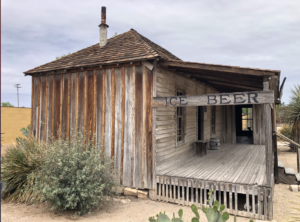 Minor offenses might bring a “fine” of having to buy a round of drinks for Bean, the jurors and anyone else in the bar.
Minor offenses might bring a “fine” of having to buy a round of drinks for Bean, the jurors and anyone else in the bar.
There was no jail in town, so prisoners awaiting trial or serving a sentence were simply chained to the only tree in Langtry.

 The governor of Texas in Austin wrote to Langtry calling attention to the fact that no funds ever came to Austin from the judge’s court proceedings. Bean’s response: “Governor, you run things there in Austin and I’ll run things here. My court never cost the state any money.” It was true. The costs of Bean’s and officer salaries were all taken from fines from the court. The matter was never addressed again.
The governor of Texas in Austin wrote to Langtry calling attention to the fact that no funds ever came to Austin from the judge’s court proceedings. Bean’s response: “Governor, you run things there in Austin and I’ll run things here. My court never cost the state any money.” It was true. The costs of Bean’s and officer salaries were all taken from fines from the court. The matter was never addressed again.
The judge had been on the “receiving end” of Wild West justice as well. In 1854 he courted a woman who was kidnapped and forced to marry a Mexican officer. Mustering up the gutsy bravado he later became known for, Bean confronted the officer – who promptly ordered Bean to be hanged. Luckily, the rope wasn’t taught, and the woman who was the object of his affection ran from her nearby hiding place and cut him down just in time. For the rest of his life, Bean bore rope scars around his neck.
By the 1890s, stories of Bean’s unconventional rulings had made him nationally famous. Travelers on the train passing through Langtry often stopped to visit the broken-down saloon, where a sign proudly declared Bean to be the “Law West of the Pecos.”
 And if they didn’t PLAN to stop, they might end up getting a visit anyway. In 1890, Bean heard that railroad developer and speculator Jay Gould would be passing through Langtry on a special train. Not one to miss an opportunity, Bean flagged down the train using a danger signal and the engineer stopped assuming a bridge must be out. Bean boldy proceeded to invite Gould and his daughter to visit the saloon as his guests. The Goulds visited for two hours, causing a brief panic on the New York Stock Exchange when it was reported that Gould had been killed in a train crash.
And if they didn’t PLAN to stop, they might end up getting a visit anyway. In 1890, Bean heard that railroad developer and speculator Jay Gould would be passing through Langtry on a special train. Not one to miss an opportunity, Bean flagged down the train using a danger signal and the engineer stopped assuming a bridge must be out. Bean boldy proceeded to invite Gould and his daughter to visit the saloon as his guests. The Goulds visited for two hours, causing a brief panic on the New York Stock Exchange when it was reported that Gould had been killed in a train crash.
Regardless of being unpredictable and moody, Bean was admired by locals for bringing the area’s lawlessness under control.
Bean and other rowdies of the day enjoyed games for fun or money in the pool hall attached to the courtroom. Although the judge’s elaborate billiards table has long been gone, the incredible metal legs of the table are still there for visitors to see. Judging by the beautiful lions’ heads and claw feet, it must have been one of the fanciest in Texas.
The Jersey Lillie had a saloon/courtroom, billiard hall, and also served as the judge’s home. In 1896 it burned, and Bean built a small version, with a separate building called the “Opera House” as his residence.
The building known as the “Opera House” was never an opera house. It ended up with that name because of a crush…well, more of an obsession…that Bean had with the famous English actress Lillie Langtry. It’s thought that he believed he could lure the celebrity to his hometown by getting the word out that they had an opera house. He wrote countless letters to the famous beauty hoping she would perform there.
And yes, he also named the famous Jersey Lilly for her…but misspelled the name. A common (understandable) misconception is that the town of Langtry was named for her as well, but it was actually named for one of the construction foremen who worked for the railroad.
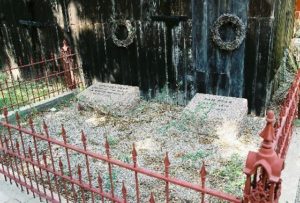 Bean became ill during a trip to San Antonio, and returned to Langtry. He passed away on March 16, 1903 in the billiard room where he had spent so many of his later years. And wouldn’t you know it? Lillie Langtry finally visited the Jersey Lillie in 1904 just 10 months after he died. Judge Roy Bean is buried with his son Sam, who was killed in a gunfight, in Del Rio on what now is the grounds of a museum.
Bean became ill during a trip to San Antonio, and returned to Langtry. He passed away on March 16, 1903 in the billiard room where he had spent so many of his later years. And wouldn’t you know it? Lillie Langtry finally visited the Jersey Lillie in 1904 just 10 months after he died. Judge Roy Bean is buried with his son Sam, who was killed in a gunfight, in Del Rio on what now is the grounds of a museum.



















